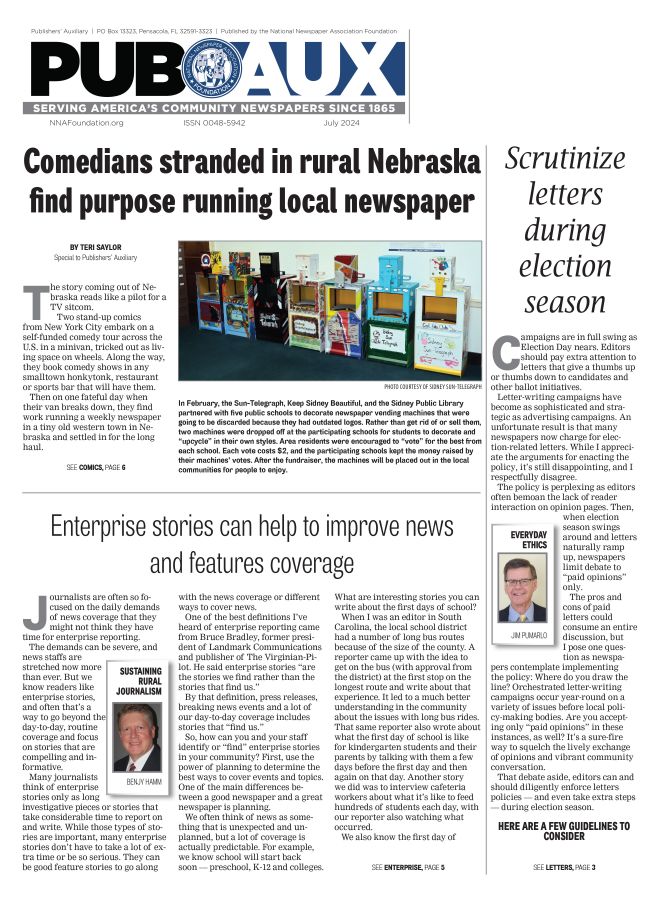New administration brings new laws and challenges
Mar 13, 2017
By Tonda Rush
Legal Standing
T
he arrival of the 45th president, Donald J. Trump, and the 115th Congress brings the potential of many legal changes for community newspapers. Here are just a few.
1. Rep. Kevin Brady’s, R-TX, House Ways and Means Committee has vowed sweeping changes in the federal tax code. The first since 1986, the proposed changes are detailed in a blueprint. Brady says legislation will be passed this year, but it might run into snags as the business lobby is fractured over the proposal. But a determined committee chair has ways to encourage consensus so it is not safe to bet against the new plan. It is worth spending some time considering both the philosophy and the possible impact on community newspapers.
a. It would tax cash flows, not net income.
b. It would emphasize domestic production and penalize imported products and materials.
c. It would give incentives to financing expansions and acquisitions through equity (e.g., sales of stock) rather than debt by disallowing the deduction of interest as a business expense.
d. It would allow the immediate expensing of business investments. For example, instead of depreciating a new computer over three years, the full cost could be counted in the first year.
e. It would eliminate the estate tax.
f. It would change the marginal rates for all corporations. C corps would be taxed at 20 percent and pass-through entities at 25 percent instead of at the owners’ personal marginal rates. It is not clear whether those would be maximum rates or a flat tax, but it appears the committee intends a flat tax, while the Trump administration is favoring a tiered set of rates.
Many blanks are to be filled in yet, probably the most important of which are figuring out how to create a transition from today’s tax system to tomorrow’s. The committee has said it doesn’t want to displace businesses that have placed bets on the incentives from the ’86 code. But exactly how it will stack up chits that might be used in the new law is one of the big puzzles to solve.
How could this change affect community newspapers? In theory, it could promote new domestic manufacturing, leading to local economic development. That is Brady’s goal. Whether it will do so and what risks must be taken to go down that path remain to be seen.
The National Newspaper Association’s board of directors is seeking views from members on the concept, even recognizing that many details are yet unknown. Members who have not yet received the tax survey but would like to provide input to the board are welcome to request another copy from me at tonda@nna.org.
2. Postal reform is always near to NNA’s core mission. This might be the year legislation finally passes, as the leadership of the oversight committees feel the hot breath of privatization forces on their necks. If a bill passes, new cuts in service might be avoided. On the other hand, a new system of calculating postage rates might arrive in early 2018, as the Postal Regulatory Commission considers the wisdom of the present system of inflation-indexed rates.
3. Newspapers in states where marijuana use has been legalized—either for recreational or medicinal purposes—are currently mailing copies with marijuana ads, even though federal law technically forbids such mail. Former Attorney General Eric Holder had issued guidance that enforcement would be restricted to a few egregious violations: like an intent to market to children. Current Attorney General Jeff Sessions has a record of intolerance for drug use. The likelihood of a revision of the Holder policy is high. Newspapers should proceed with caution and if possible, restrict marijuana ads to copies delivered outside the mail and only within the border of a legal-use state until Sessions has had time to consider his own prosecutorial priorities.
4. Medical insurance will be uncertain until revisions of the Affordable Care Act—known as ACA or Obamacare—are known. Although the GOP campaigned heavily on repealing ACA, it is finding that certain provisions are not as unpopular as the party thought. Although it would like to eliminate the mandate for every individual either to have health insurance or pay a fine, it would also like to keep the requirement for insurance to cover pre-existing conditions. Drafting a replacement that grants both wishes has proven trickier than the leadership thought. Insurance companies will react conservatively until they know their potential exposure under a new law, if there is one. Recommendation: prayer. The complexities of health insurance bedevil every small business.
5. Having undocumented workers on the payroll becomes more hazardous than ever, with the new emphasis on people living in the country illegally coming out of Washington since January. Rumors of raids began to make headlines within two weeks of the new administration’s pledge to crack down. Penalties against employers can be heavy. Employers must have an I-9 form for every employee within three days of hiring or face a fine of $110 to $1,100. Employers also have the obligation to examine the employee’s documents, so don’t just take a worker’s word for it that a green card is somewhere in his or her home. Fines for violation can run as high as $10,000 per employee, and repeated or multiple offenses can carry prison terms.
6. Finally, what of the new overtime rule? It is on hold, pending a federal court appeal. But the likelihood is that regardless of the court’s ruling, the rule will be revised or dropped. Until further notice, the old salary threshold of $23,440 remaining in effect for exempt employees.







